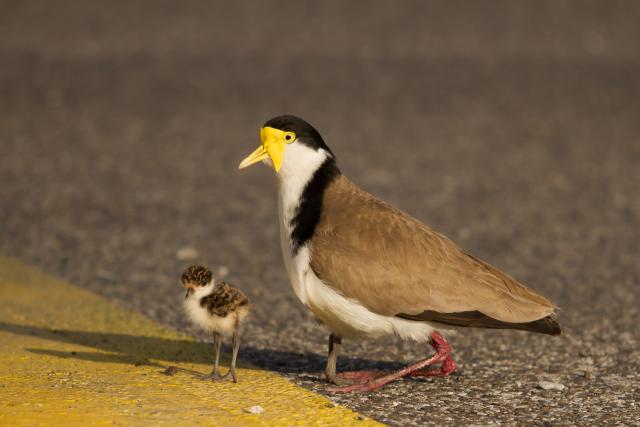By Tyler Wright
This year’s bird swooping season has Aylee Sunstrom currently in fear of going into her own backyard as swoop season hits full swing.
The Tecoma local said she was recently hit in the back of the head by a plover bird protecting its young.
“This is the third time this year that the birds have come in, and they sit on our roof,” Aylee said.
“There’s two of them – but this time they got more aggressive, and I can’t tell you how long they’re there for.”
Aylee hasn’t been outside to clean the pool since late August, when she found her six-year-old child crawled up under their trampoline in fear of being attacked.
“My fear is that it could knock me unconscious and I could end up face down in the pool,” Aylee said.
“People say ‘take an umbrella’ and ‘wear a helmet,’ but I’ve seen them swoop down on my daughter, on her back; she’s only six, and they’ll go right down low and knock her as well.
“I can’t hang the washing out or clean the pool.”
BirdLife Australia’s Sean Dooley said the organisation does not have a handle on the numbers of plovers – otherwise known as Masked Lapwings – but they are still common in Victoria, except in built-up areas where they are “gradually declining due to disturbance and lack of open spaces”.
“I’m amazed that they survive in the suburbs at all given the amount of people, cats, dogs and foxes that are around to disturb them off the nest or take the eggs and chicks. We know that since they removed all foxes on Phillip Island that numbers have been going up there,” Mr Dooley said.
“In terms of the Dandenongs area, they wouldn’t naturally have been very common originally as they avoid forested areas. But they would have occurred along the flats and billabongs along the Yarra.
“Today they are common in cleared areas and into the edges of towns. Our Birdata system doesn’t seem to indicate they occur in higher numbers in the Dandenongs/Yarra Valley area compared to other parts of Victoria, but the difference is that with so many people living on acreage, there are more opportunities for people and lapwings to come into contact, and hence a possibly higher rate of reporting of swooping, though we don’t have data on that.”
Plover birds tend to nest in late winter into early spring, Mr Dooley said, with swooping season set to be “finishing soon”.
“Being swooped like this can be terrifying, and is made even more so because they have a yellow spike (or spur) on the bend of the wing that could potentially cause harm,” he said.
“Usually the lapwing parents don’t actually hit people as there is a risk they will be injured too, but occasionally it does happen. Especially if the source of the threat doesn’t move out of the nest zone.
“Like Magpies they usually only defend the nest within a certain zone so in most cases just moving out of that zone (which is probably only around a 50-metre radius will cause the swooping to stop). But it’s not much use if they are nesting in your yard or nature strip or paddock near somewhere you have to be.”
He said the best advice for someone who can’t avoid the birds is to ensure to keep an eye on the birds so you can see them approach.
“Generally they will approach from behind but it’s important to protect your eyes as if they do come from the front there is an outside chance they could do some damage to your eyes. Moving out of the area as quickly as possible is the best thing you can do but if you stand your ground and shout and wave at them or throw things, that is likely to ramp up the swooping behaviour as it confirms to them that you are a threat to their young.”
“It’s important to note that Masked Lapwings are native birds and are protected under wildlife laws.”
In a media release issued on Wednesday 6 September, the Department of Energy, Environment and Climate Action (DEECA) reminded Victorians that some native birds – including plovers and magpies – may swoop during their breeding season.
DEECA’s senior wildlife officer, Katherine Whittaker, said every spring, some native birds swoop to defend their eggs and young for a “short time” while their young are “most vulnerable”.
“While swooping is unsettling, it’s normal behaviour for a range of native birds. Swooping is a warning to people and animals not to come near their young. It’s rare for birds to make contact,” Ms Whittaker said.
Native birds swoop in urban and rural areas, parks and gardens, along bike tracks or anywhere that birds are nesting.
“Not all birds swoop during the breeding season, so don’t be concerned simply because there are magpies or other common swooping birds in the area,” Ms Whittaker said.
“Remember, the swooping behaviour will only last for a few weeks, normally stopping soon after the young leave the nest.”
Those who are worried about being caught out by a protective bird this spring are advised to take the following steps:
Know your local swooping hotspots and avoid the area
Move quickly but do not run
Wear protective head and eye coverings
Don’t harass birds – this can make swooping worse
Don’t feed the birds and do not destroy their nests
People can also plan their route around known swooping hotspots and report a swooping incident on Victoria’s interactive swooping bird map by visiting: wildlife.vic.gov.au/managing-wildlife/swooping-birds
All Victorian native wildlife is protected by law, and it is illegal to harass or harm native birds and other wildlife without authorisation.
People can report wildlife crime such as harassing, harming or disturbing wildlife to Crime Stoppers Victoria on 1800 333 000.







